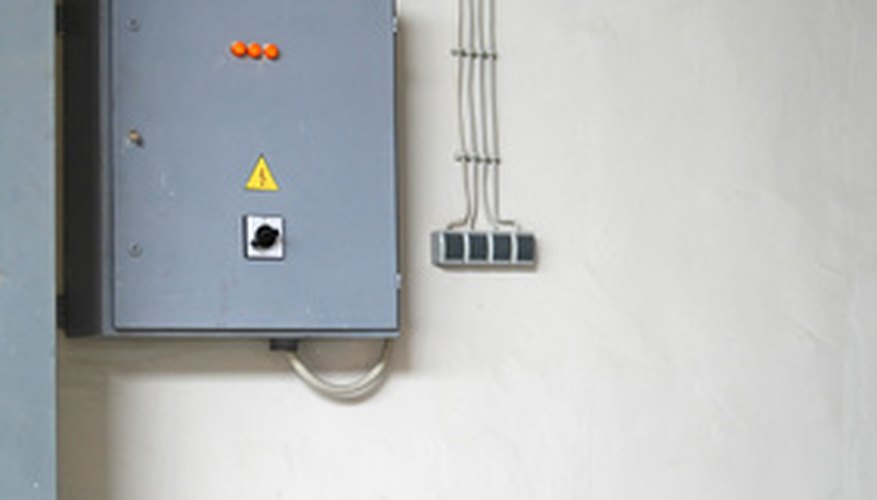The three most common reasons a homeowner would need to add a subsidiary electric panel, commonly called a "sub-panel," are a disconnect for a large appliance, an outbuilding -- such as a garage, greenhouse or barn -- or the main panel box is full and additional room for more circuit breakers is needed. Adding more circuit breakers or a sub-panel does not mean you will have more power available to your home. What determines how much electricity you have available in your home is the main electric service, which means the gauge of the wire you have coming into your main panel from the transformer on the telephone pole and the amperage capacity of your main breaker, such as 100-amp, 150-amp or 200-amp. The most common is a 150-amp main service breaker.
- The three most common reasons a homeowner would need to add a subsidiary electric panel, commonly called a "sub-panel," are a disconnect for a large appliance, an outbuilding -- such as a garage, greenhouse or barn -- or the main panel box is full and additional room for more circuit breakers is needed.
A disconnect sub-panel box for a large appliance is required if the appliance is over 300 volts-amperes and is not in sight of the main panel box with the circuit breaker that provides the appliance the electricity.
The most common sub-panels in a garage are 60-amp and 100-amp. Sub-panels generally do not have a main breaker in them; the main breaker for the sub-panel is in the main panel box. If you want your sub-panel to have a main breaker it will have to be smaller then a the breaker in the main panel box. The most common sub-panel for an outbuilding is a 60-amps breaker.
The wire has to be in conduit if it is not going to be in a finished wall. Run conduit or drill holes in the wall studs or floor joists from the main panel box to the location where the sub-panel is to be installed.
Attach the wall backers, which are boards cut and nailed between wall studs to which to screw the sub-panel if it will be recessed into the wall. If the sub-panel is going to be mounted on the wall, cut a piece of plywood six inches longer and wider than the sub-panel and paint the plywood black.
- The wire has to be in conduit if it is not going to be in a finished wall.
- Attach the wall backers, which are boards cut and nailed between wall studs to which to screw the sub-panel if it will be recessed into the wall.
Attach the sub-panel in between wall studs using screws or screw the prepared plywood backer to the wall, Attach the sub-panel in the centre of the plywood and run conduit to the sub-panel if using conduit. Run the wire from the main panel to the sub-panel.
Break out a round cut-out in the sub-panel, which is called a "knock-out" or "KO," with pliers. Install a connector into the "knock-out" and run wire into the sub-panel. Cut the plastic coating off the wire, then go back to the connector and strip off one half inch of the end of the wires.
Connect the white wire to the neutral buss bar located on the side in the sub-panel, and connect the bare copper ground to the ground buss bar, which is attached directly to the sub-panel. If the sub-panel has a main breaker, attach the red and black wire to the screws on the breaker (it does not matter which wire goes on which screw); if the sub-panel does not have a main breaker, you will attach the red and black wires to the main lugs on the main buss, which are the big lugs at the top.
- Connect the white wire to the neutral buss bar located on the side in the sub-panel, and connect the bare copper ground to the ground buss bar, which is attached directly to the sub-panel.
Turn off the main breaker and remove the cover of the main panel box. Push or screw the breaker for the sub-panel, depending on the style of panel you have, into the main buss. Follow Step 4 to prepare wires in the main panel.
Connect the white wire to the neutral buss bar, connect the ground wire to the ground bar and the red and black wires will go into the screws on the new breaker. Replace the cover to the panel box. When you have installed breakers into the sub-panel and replaced the cover, you may turn on the breaker to the sub-panel and test the sub-panel with a voltage meter.
TIP
The holes in the wall studs and floor joists that you run the wire through need to be 1½ inches into the wood or covered with metal plates, so the nails or screws will not puncture the wires when the wall is being finished. If the wire is run in an attic, the wire can run over the joist and be stapled at least every four feet.
WARNING
The wires that provide power to the main breaker in the main panel box still have electricity in them. Check local codes before starting your project; the National Electrical Code (NEC) may vary from local codes. Use rubber insulated gloves when working with electricity. Never work in the panel box when it is "live."
